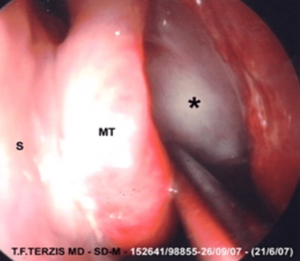Endoscopic Decompression of the Orbit in Thyroid Disease
In thyroid hyperfunction, the thyroid hormones may cause swelling of the muscles and fat surrounding the eye. This produces increase of pressure inside the orbit, which is the bony box containing the eyeball. The eye is pushed out and protrudes anteriorly (exophthalmos). This condition, apart from causing the obvious aesthetic problem, may also put the vision in danger, due to possible pressure damage to the sensitive optic nerve. Therefore, in selected cases of exophthalmos, surgical decompression of the orbit may be necessary.

Traditional surgical techniques use external incisions to remove part of the bony walls of the orbit. When indicated, endoscopic surgery provides a much simpler alternative. Through the nostril, without external incisions, the surgeon removes the thin bony wall between the nose and the orbit, and allows relief of the increased pressure towards the nasal cavity. Before any decompression procedure, a thorough evaluation by both the Endocrinologist and the Ophthalmologist is important. The specialized Ophthalmic surgeon, called occuloplastic surgeon, is usually present during the operation.
This website aims at providing simplified scientific information and not medical advice on specific conditions or individual cases. In this respect, it cannot replace the consultation and documented opinion of a specialist physician.
